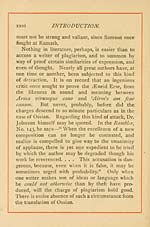Ossian Collection > Poems of Ossian
(29)
Download files
Complete book:
Individual page:
Thumbnail gallery: Grid view | List view

INTRODUCTION. xxvii
Much detraction of Macpherson's work has been
based on the translator's own letters and on his
efforts in archaeology. In a letter to Dr. Blair he
remarked " that his Highland pride was alarmed
at appearing to the world only as a translator."
Again, in the preface to the edition of 1773,
Macpherson wrote regarding improvements in his
version : " Errors in diction might have been com-
mitted at twenty-four which the experience of a
riper age may remove, and some exuberances in
imagery may be restrained with advantage by a
degree of judgment acquired in the progress of
time." Upon these words Laing insisted that
Macpherson claimed for himself the authorship of
the Ossianic poems. Less prejudiced critics can
take a more obvious meaning from them. In the
same page with the latter extract Macpherson
twice expressly alludes to himself as "the Trans-
lator." Had he been anything more than this he
would certainly have used a more distinct means
of making his merit known, since self-effacement
was by no means a conspicuous trait of his
character. Also, in his introduction to " Comala,"
. Macpherson asserted that the Caracul referred
to in that poem was the Caracalla of the
Roman writers. Now, "Gibbon has noted that this
was a name given to Antoninus, the son of Sevei us,
four years after his defeat by the Caledonians in 211
Much detraction of Macpherson's work has been
based on the translator's own letters and on his
efforts in archaeology. In a letter to Dr. Blair he
remarked " that his Highland pride was alarmed
at appearing to the world only as a translator."
Again, in the preface to the edition of 1773,
Macpherson wrote regarding improvements in his
version : " Errors in diction might have been com-
mitted at twenty-four which the experience of a
riper age may remove, and some exuberances in
imagery may be restrained with advantage by a
degree of judgment acquired in the progress of
time." Upon these words Laing insisted that
Macpherson claimed for himself the authorship of
the Ossianic poems. Less prejudiced critics can
take a more obvious meaning from them. In the
same page with the latter extract Macpherson
twice expressly alludes to himself as "the Trans-
lator." Had he been anything more than this he
would certainly have used a more distinct means
of making his merit known, since self-effacement
was by no means a conspicuous trait of his
character. Also, in his introduction to " Comala,"
. Macpherson asserted that the Caracul referred
to in that poem was the Caracalla of the
Roman writers. Now, "Gibbon has noted that this
was a name given to Antoninus, the son of Sevei us,
four years after his defeat by the Caledonians in 211
Set display mode to: Large image | Transcription
Images and transcriptions on this page, including medium image downloads, may be used under the Creative Commons Attribution 4.0 International Licence unless otherwise stated. ![]()
| Early Gaelic Book Collections > Ossian Collection > Poems of Ossian > (29) |
|---|
| Permanent URL | https://digital.nls.uk/77843767 |
|---|
| Description | Selected books from the Ossian Collection of 327 volumes, originally assembled by J. Norman Methven of Perth. Different editions and translations of James MacPherson's epic poem 'Ossian', some with a map of the 'Kingdom of Connor'. Also secondary material relating to Ossianic poetry and the Ossian controversy. |
|---|
| Description | Selected items from five 'Special and Named Printed Collections'. Includes books in Gaelic and other Celtic languages, works about the Gaels, their languages, literature, culture and history. |
|---|

